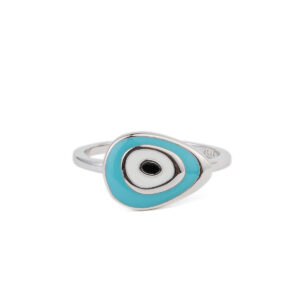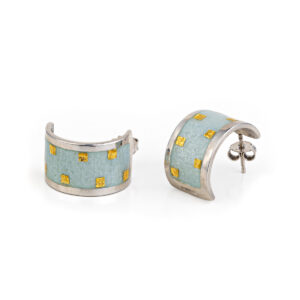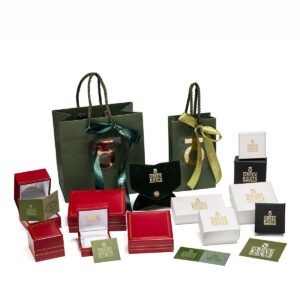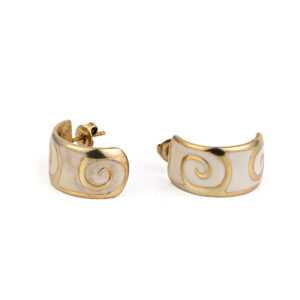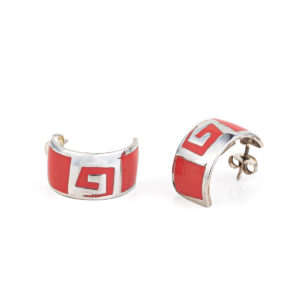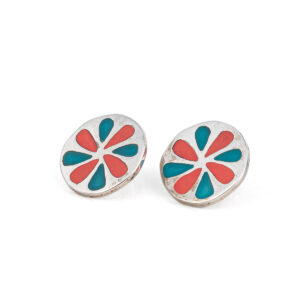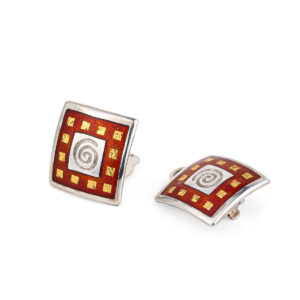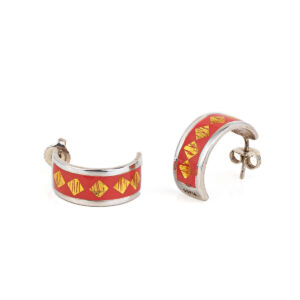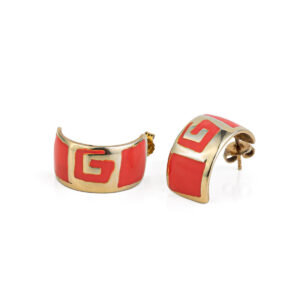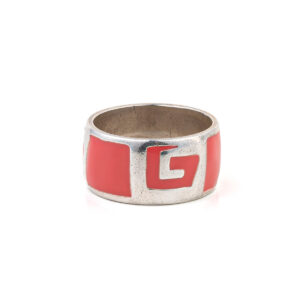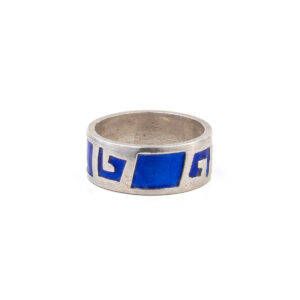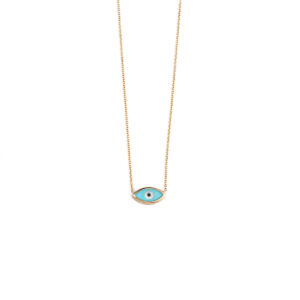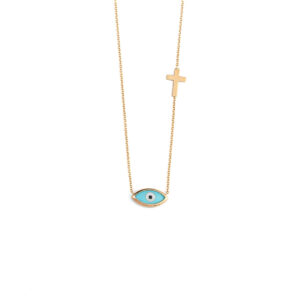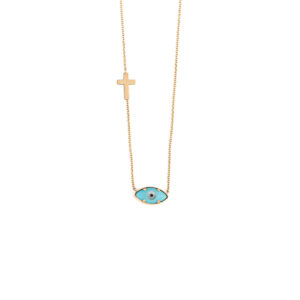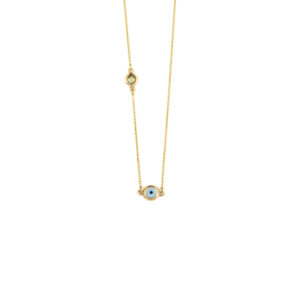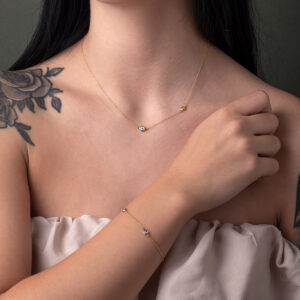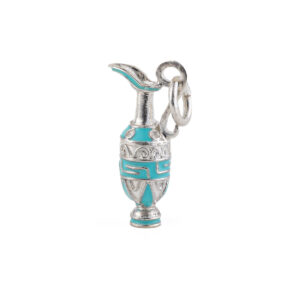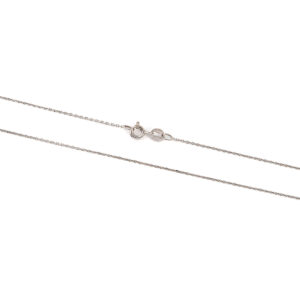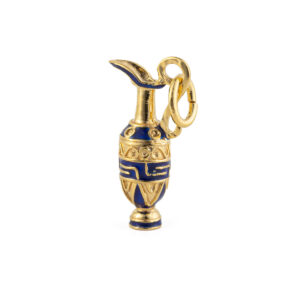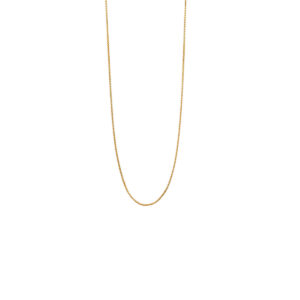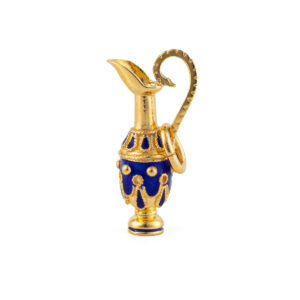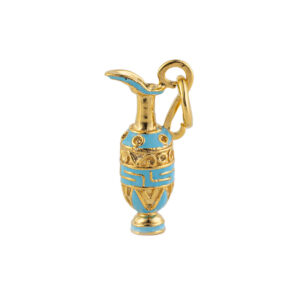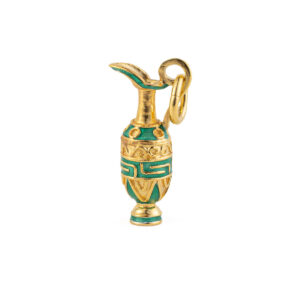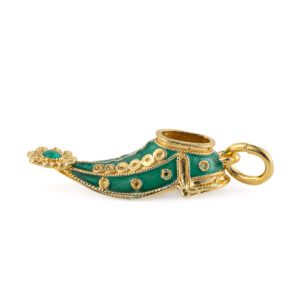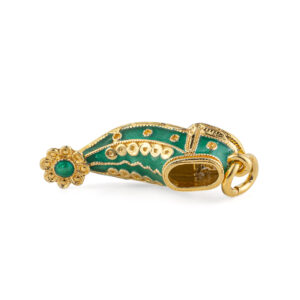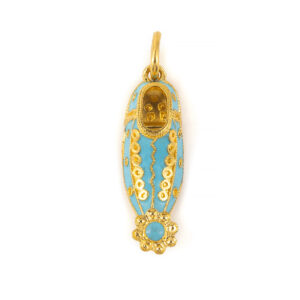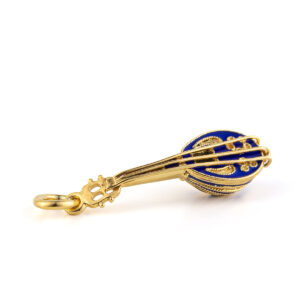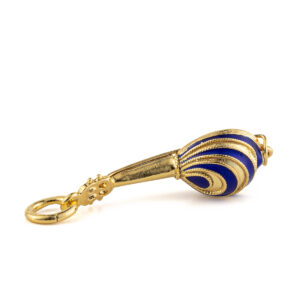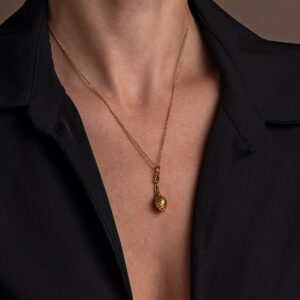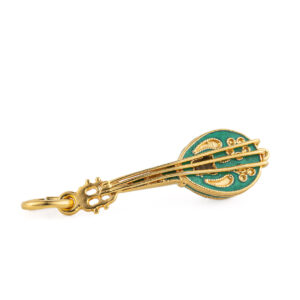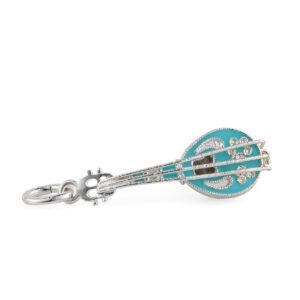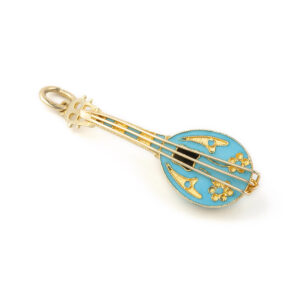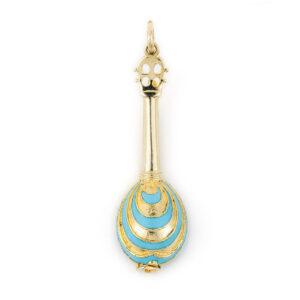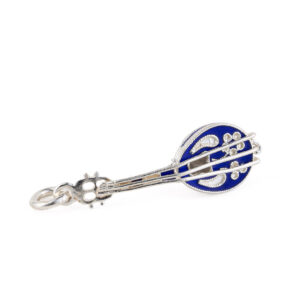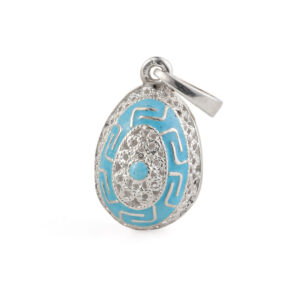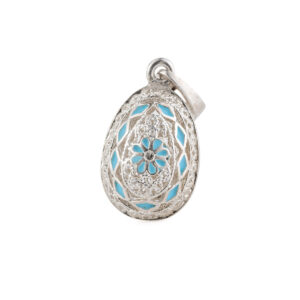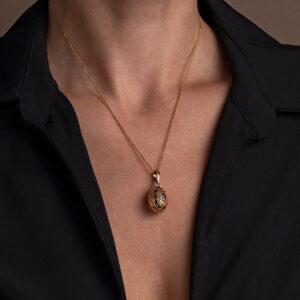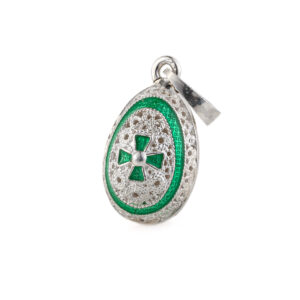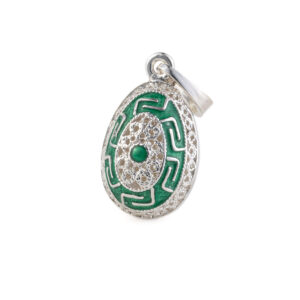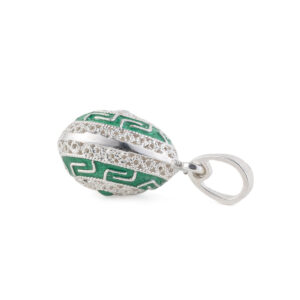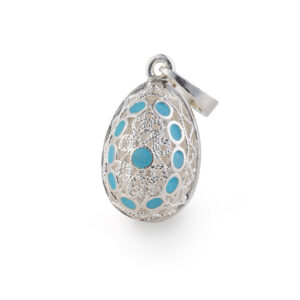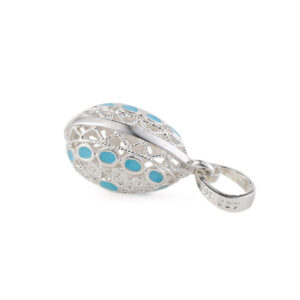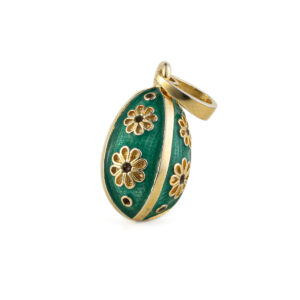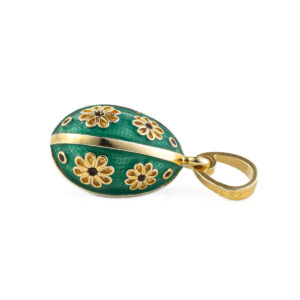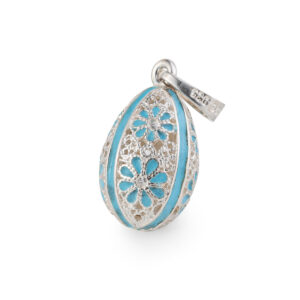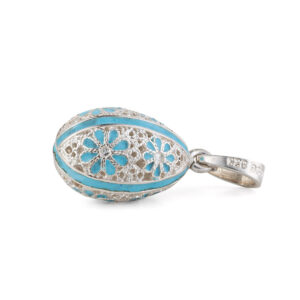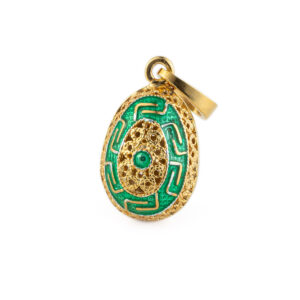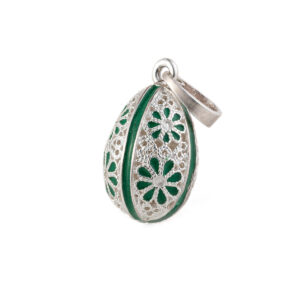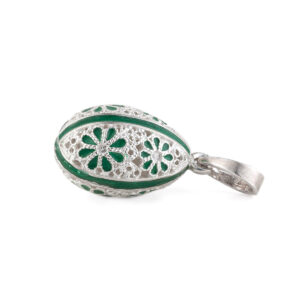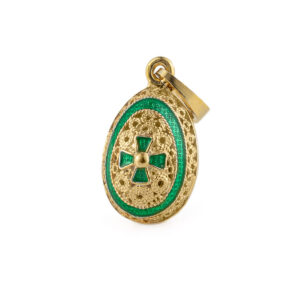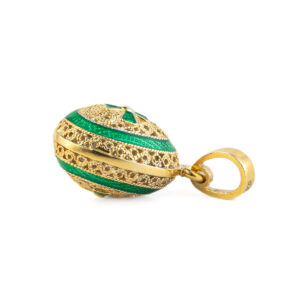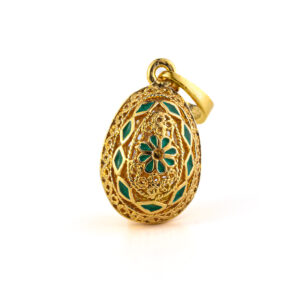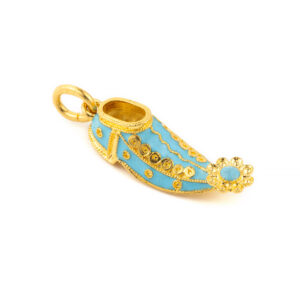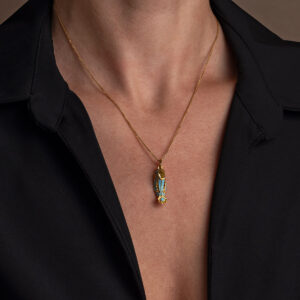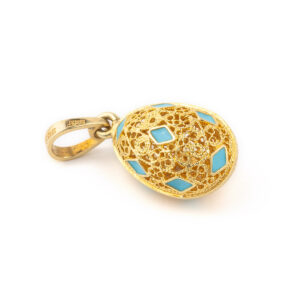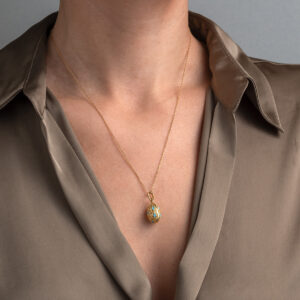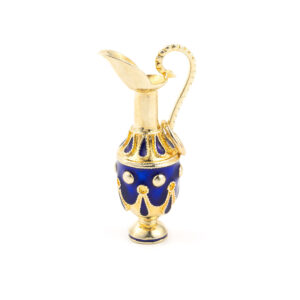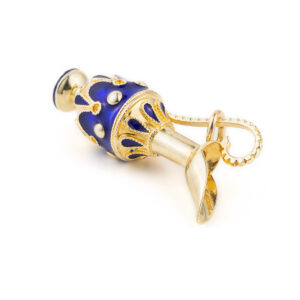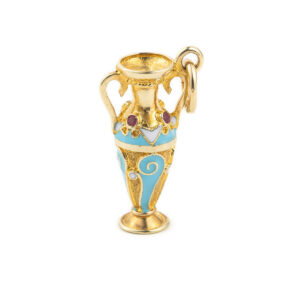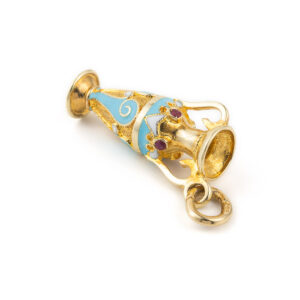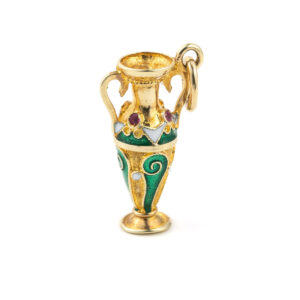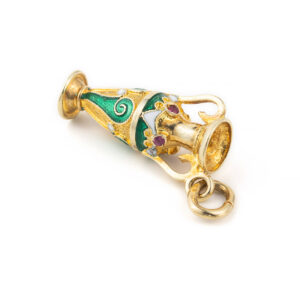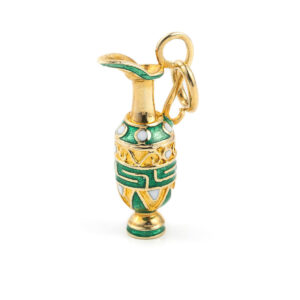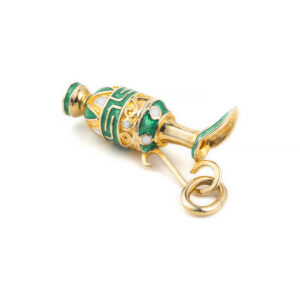Καρφωτά Σκουλαρίκια με Γαλάζιο Σμάλτο – Ασήμι 925
Κατασκευασμένα από ασήμι 925°.
Χειροποίητο ελληνικό κόσμημα.
Ανακαλύψτε περισσότερες Προσφορές
Σκουλαρίκια Μαίανδρος με Σμάλτο – Επιχρυσωμένο Ασήμι 925
Σκουλαρίκια εμπνευσμένα από το αρχαιοελληνικό σύμβολο του μαιάνδρου.
Κατασκευασμένα από ασήμι 925°.
Χειροποίητο ελληνικό κόσμημα.
Ανακαλύψτε τη Συλλογή Μαίανδρος
Το σχέδιο του Μαιάνδρου είναι ένα διακοσμητικό περίγραμμα κατασκευασμένο από μια συνεχή γραμμή, διαμορφωμένο σε ένα επαναλαμβανόμενο μοτίβο. Το συναντάμε επίσης με την ονομασία “ελληνικό κλειδί”. Από τη μία πλευρά, το όνομα μαίανδρος θυμίζει τη στροφή του ποταμού Μαιάνδρου στη Μικρά Ασία, και από την άλλη, όπως τόνισε ο Karl Kerenyi, «ο μαίανδρος είναι η μορφή ενός λαβύρινθου σε γραμμική μορφή». Λόγω της έλλειψης αρχής και τέλους, γίνεται το σύμβολο της μακράς ζωής και της αιωνιότητας. Ένα από τα αρχαιότερα μοτίβα που έχει διακοσμήσει πολλούς ναούς και αγάλματα.
Καρφωτά Σκουλαρίκια Σπείρα με Σμάλτο – Ασήμι 925
Κατασκευασμένα από ασήμι 925°.
Χειροποίητο Ελληνικό Κόσμημα
Ανακαλύψτε περισσότερες Προσφορές
Βραχιόλι εμπνευσμένο από το αρχαίο μοτίβο της σπείρας.
Η σπείρα είναι ένα από τα παλαιότερα σύμβολα της ανθρώπινης πνευματικότητας, σκαλισμένο ή ζωγραφισμένο σε βράχους χιλιάδες χρόνια πριν. Σύμβολο της κίνησης και της προοδευτικής ανάπτυξης, της ανάπτυξης, της επέκτασης, της κοσμικής ενέργειας και σύμβολο του ήλιου.. Σπείρες έχουν βρεθεί σε χώρους ταφής, σε αγγεία, σε κοσμήματα, ρούχα, όπλα… Μπορούν να παρατηρηθούν σε κάθε πτυχή της φύσης, όπως οι παλίρροιες στους ωκεανούς, οι άνεμοι, τα φυτά και τα κοχύλια. Το φαινόμενο της σπείρας έχει εξηγηθεί μέσω των μαθηματικών από την εποχή του Αρχιμήδη, του μεγάλου Έλληνα μαθηματικού.
Καρφωτά Σκουλαρίκια Σπείρα με Μπλε Σμάλτο – Επιχρυσωμένο Ασήμι 925
Κατασκευασμένα από ασήμι 925°.
Χειροποίητο Ελληνικό Κόσμημα
Ανακαλύψτε τη Συλλογή Σπείρα
Βραχιόλι εμπνευσμένο από το αρχαίο μοτίβο της σπείρας.
Η σπείρα είναι ένα από τα παλαιότερα σύμβολα της ανθρώπινης πνευματικότητας, σκαλισμένο ή ζωγραφισμένο σε βράχους χιλιάδες χρόνια πριν. Σύμβολο της κίνησης και της προοδευτικής ανάπτυξης, της ανάπτυξης, της επέκτασης, της κοσμικής ενέργειας και σύμβολο του ήλιου.. Σπείρες έχουν βρεθεί σε χώρους ταφής, σε αγγεία, σε κοσμήματα, ρούχα, όπλα… Μπορούν να παρατηρηθούν σε κάθε πτυχή της φύσης, όπως οι παλίρροιες στους ωκεανούς, οι άνεμοι, τα φυτά και τα κοχύλια. Το φαινόμενο της σπείρας έχει εξηγηθεί μέσω των μαθηματικών από την εποχή του Αρχιμήδη, του μεγάλου Έλληνα μαθηματικού.
Καρφωτά Σκουλαρίκια Σπείρα με Λευκό Σμάλτο – Επιχρυσωμένο Ασήμι 925
Κατασκευασμένα από ασήμι 925°.
Χειροποίητο Ελληνικό Κόσμημα
Ανακαλύψτε τη Συλλογή Σπείρα
Βραχιόλι εμπνευσμένο από το αρχαίο μοτίβο της σπείρας.
Η σπείρα είναι ένα από τα παλαιότερα σύμβολα της ανθρώπινης πνευματικότητας, σκαλισμένο ή ζωγραφισμένο σε βράχους χιλιάδες χρόνια πριν. Σύμβολο της κίνησης και της προοδευτικής ανάπτυξης, της ανάπτυξης, της επέκτασης, της κοσμικής ενέργειας και σύμβολο του ήλιου.. Σπείρες έχουν βρεθεί σε χώρους ταφής, σε αγγεία, σε κοσμήματα, ρούχα, όπλα… Μπορούν να παρατηρηθούν σε κάθε πτυχή της φύσης, όπως οι παλίρροιες στους ωκεανούς, οι άνεμοι, τα φυτά και τα κοχύλια. Το φαινόμενο της σπείρας έχει εξηγηθεί μέσω των μαθηματικών από την εποχή του Αρχιμήδη, του μεγάλου Έλληνα μαθηματικού.
Καρφωτά Σκουλαρίκια Μαίανδρος με Σμάλτο -Ασήμι 925
Σκουλαρίκια εμπνευσμένα από το ελληνικό σύμβολο του μαιάνδρου.
Κατασκευασμένα από ασήμι 925°.
Χειροποίητο ελληνικό κόσμημα.
Ανακαλύψτε τη Συλλογή Μαίανδρος
Το σχέδιο του Μαιάνδρου είναι ένα διακοσμητικό περίγραμμα κατασκευασμένο από μια συνεχή γραμμή, διαμορφωμένο σε ένα επαναλαμβανόμενο μοτίβο. Το συναντάμε επίσης με την ονομασία “ελληνικό κλειδί”. Από τη μία πλευρά, το όνομα μαίανδρος θυμίζει τη στροφή του ποταμού Μαιάνδρου στη Μικρά Ασία, και από την άλλη, όπως τόνισε ο Karl Kerenyi, «ο μαίανδρος είναι η μορφή ενός λαβύρινθου σε γραμμική μορφή». Λόγω της έλλειψης αρχής και τέλους, γίνεται το σύμβολο της μακράς ζωής και της αιωνιότητας. Ένα από τα αρχαιότερα μοτίβα που έχει διακοσμήσει πολλούς ναούς και αγάλματα.
Στρογγυλά Πολύχρωμα Καρφωτά Σκουλαρίκια – Ασήμι 925
Κατασκευασμένα από ασήμι 925°.
Χειροποίητο ελληνικό κόσμημα.
Ανακαλύψτε περισσότερες Προσφορές
Σκουλαρίκια Τετράγωνα Σπείρα με Σμάλτο – Ασήμι 925
Κατασκευασμένα από ασήμι 925°.
Χειρποίητο ελληνικό κόσμημα.
Ανακλύψτε τη Συλλογή Σπείρα
Η σπείρα είναι ένα από τα παλαιότερα σύμβολα της ανθρώπινης πνευματικότητας, λαξευμένη ή ζωγραφισμένη σε βράχους από χιλιάδες χρόνια πριν. Σύμβολο κίνησης και προοδευτικής ανάπτυξης, επέκτασης, κοσμικής ενέργειας και σύμβολο του ήλιου. Σπείρες έχουν βρεθεί σε ταφικά αγγεία, σε κοσμήματα, ρούχα και όπλα. Μπορούν να φανούν από κάθε άποψη στη φύση, όπως στις παλίρροιες στους ωκεανούς, τους ανέμους, τα φυτά, τα κοχύλια. Το φαινόμενο της σπείρας έχει εξηγηθεί και στα μαθηματικά από την εποχή του Αρχιμήδη, του μεγάλου Έλληνα μαθηματικού.
Καρφωτά Σκουλαρίκια Ρόμβος με Σμάλτο – Ασήμι 925
Κατασκευασμένο από ασήμι 925°.
Χειροποίητο ελληνικό κόσμημα.
Ανακαλύψτε περισσότερες Προσφορές
Σκουλαρίκια Μαίανδρος με Σμάλτο – Επιχρυσωμένο Ασήμι 925
Σκουλαρίκια εμπνευσμένα από το αρχαιοελληνικό σύμβολο του μαιάνδρου.
Κατασκευασμένα από ασήμι 925°.
Χειροποίητο ελληνικό κόσμημα.
Ανακαλύψτε τη Συλλογή Μαίανδρος
Το σχέδιο του Μαιάνδρου είναι ένα διακοσμητικό περίγραμμα κατασκευασμένο από μια συνεχή γραμμή, διαμορφωμένο σε ένα επαναλαμβανόμενο μοτίβο. Το συναντάμε επίσης με την ονομασία “ελληνικό κλειδί”. Από τη μία πλευρά, το όνομα μαίανδρος θυμίζει τη στροφή του ποταμού Μαιάνδρου στη Μικρά Ασία, και από την άλλη, όπως τόνισε ο Karl Kerenyi, «ο μαίανδρος είναι η μορφή ενός λαβύρινθου σε γραμμική μορφή». Λόγω της έλλειψης αρχής και τέλους, γίνεται το σύμβολο της μακράς ζωής και της αιωνιότητας. Ένα από τα αρχαιότερα μοτίβα που έχει διακοσμήσει πολλούς ναούς και αγάλματα.
Δαχτυλίδι Μαίανδρος Ροζ Σμάλτο – Ασήμι 925
Δαχτυλίδι εμπνευσμένο από το ελληνικό σύμβολο του μαιάνδρου.
Χειροποίητο Ελληνικό Κόσμημα.
Ανακαλύψτε τη Συλλογή Μαίανδρος
Ιστορία
Το σχέδιο Μαιάνδρου είναι ένα διακοσμητικό περίγραμμα που δημιουργείται από μια συνεχή γραμμή, η οποία σχηματίζεται σε ένα επαναλαμβανόμενο μοτίβο. Ένα τέτοιο σχέδιο ονομάζεται επίσης ελληνικός κροσσός ή ελληνικό σχέδιο κλειδιού, αν και πρόκειται για σύγχρονες ονομασίες. Από τη μία πλευρά, η ονομασία “μαίανδρος” θυμίζει τη στροφική πορεία του ποταμού Μαιάνδρου στη Μικρά Ασία, και από την άλλη πλευρά, όπως επεσήμανε ο Karl Kerenyi, “ο μαίανδρος είναι το σχήμα ενός λαβύρινθου σε γραμμική μορφή” το νόημα είναι ότι δεν υπάρχει αρχή και τέλος σε ορισμένες περιπτώσεις έτσι γίνεται το σύμβολο της μακράς ζωής και της αιωνιότητας.
Δαχτυλίδι Μαίανδρος Μπλε Σμάλτο – Ασήμι 925
Δαχτυλίδι εμπνευσμένο από το ελληνικό σύμβολο του μαιάνδρου.
Κατασκευασμένο από ασήμι 925°.
Χειροποίητο Ελληνικό Κόσμημα.
Ανακαλύψτε τη Συλλογή Μαίανδρος
Ιστορία
Το σχέδιο Μαιάνδρου είναι ένα διακοσμητικό περίγραμμα που δημιουργείται από μια συνεχή γραμμή, η οποία σχηματίζεται σε ένα επαναλαμβανόμενο μοτίβο. Ένα τέτοιο σχέδιο ονομάζεται επίσης ελληνικός κροσσός ή ελληνικό σχέδιο κλειδιού, αν και πρόκειται για σύγχρονες ονομασίες. Από τη μία πλευρά, η ονομασία “μαίανδρος” θυμίζει τη στροφική πορεία του ποταμού Μαιάνδρου στη Μικρά Ασία, και από την άλλη πλευρά, όπως επεσήμανε ο Karl Kerenyi, “ο μαίανδρος είναι το σχήμα ενός λαβύρινθου σε γραμμική μορφή” το νόημα είναι ότι δεν υπάρχει αρχή και τέλος σε ορισμένες περιπτώσεις έτσι γίνεται το σύμβολο της μακράς ζωής και της αιωνιότητας.
Χρυσό Κολιέ Μάτι – 9K
179,00€Φτιαγμένο από χρυσό 9Κ.
Χειροποίητο κόσμημα.
The symbol and superstition of the evil eye is one of the strongest symbolic images in the world. The earliest known evidence for belief in the evil eye goes back to ancient Greece and Rome. It is supposed to wear off evil to anyone who wears it.
Κολιέ Με Μάτι και Σταυρό – 9Κ Χρυσό
195,00€Φτιαγμένο από χρυσό 9Κ.
Χειροποίητο κόσμημα.
The symbol and superstition of the evil eye is one of the strongest symbolic images in the world. The earliest known evidence for belief in the evil eye goes back to ancient Greece and Rome. It is supposed to wear off evil to anyone who wears it.
Κολιέ με Μάτι Κυκλικό – 14Κ Χρυσό
642,00€Φτιαγμένο από χρυσό 14Κ.
Χειροποίητο κόσμημα.
The symbol and superstition of the evil eye is one of the strongest symbolic images in the world. The earliest known evidence for belief in the evil eye goes back to ancient Greece and Rome. It is supposed to wear off evil to anyone who wears it.
Κολιέ με Μενταγιόν Αμφορέας – Ασήμι 925
Ancient Greek Amphora Pendant with enamel and Meander design.
Design inspired by the ancient Greek history.
Made of sterling silver.
Handmade item
Amphora is a Greco – Roman word developed in ancient Greek during the Bronze Age. An amphora is a type of container of a characteristic shape and size. Amphorae were used for the transport and storage of various products, both liquid and dry, but mostly for wine. They are most often ceramic. the amphorae used in Ancient Greek vase painting. (source wikipedia)
Meander or Meandros design, one of the most historic symbols of the Greek World, also called Greek Key and symbolizes long life and eternity. The pattern with Meander was used in antiquity to decorate the frieze of temples.
Κολιέ με Μενταγιόν Αμφορέας – Ασήμι 925 Επιχρυσωμένο
Ancient Greek Amphora Pendant with enamel and Meander design.
Design inspired by the ancient Greek history.
Made of sterling silver and gold plated.
Handmade item
Amphora is a Greco – Roman word developed in ancient Greek during the Bronze Age. An amphora is a type of container of a characteristic shape and size. Amphorae were used for the transport and storage of various products, both liquid and dry, but mostly for wine. They are most often ceramic. the amphorae used in Ancient Greek vase painting. (source wikipedia)
Meander or Meandros design, one of the most historic symbols of the Greek World, also called Greek Key and symbolizes long life and eternity. The pattern with Meander was used in antiquity to decorate the frieze of temples.
Κολιέ με Μενταγιόν Αμφορέας – Ασήμι 925 Επιχρυσωμένο
Ancient Greek Amphora Pendant with enamel.
Design inspired by the ancient Greek history.
Made of sterling silver and gold plated.
Handmade item
Amphora is a Greco – Roman word developed in ancient Greek during the Bronze Age. An amphora is a type of container of a characteristic shape and size. Amphorae were used for the transport and storage of various products, both liquid and dry, but mostly for wine. They are most often ceramic. the amphorae used in Ancient Greek vase painting. (source wikipedia)
Κολιέ με Μενταγιόν Αμφορέας – Ασήμι 925 Επιχρυσωμένο
Ancient Greek Amphora Pendant with enamel and Meander design.
Design inspired by the ancient Greek history.
Made of sterling silver and gold plated.
Handmade item
Amphora is a Greco – Roman word developed in ancient Greek during the Bronze Age. An amphora is a type of container of a characteristic shape and size. Amphorae were used for the transport and storage of various products, both liquid and dry, but mostly for wine. They are most often ceramic. the amphorae used in Ancient Greek vase painting. (source wikipedia)
Meander or Meandros design, one of the most historic symbols of the Greek World, also called Greek Key and symbolizes long life and eternity. The pattern with Meander was used in antiquity to decorate the frieze of temples.
Κολιέ με Μενταγιόν Αμφορέας – Ασήμι 925 Επιχρυσωμένο
Ancient Greek Amphora Pendant with enamel.
Design inspired by the ancient Greek history.
Made of sterling silver and gold plated.
Handmade item
Amphora is a Greco – Roman word developed in ancient Greek during the Bronze Age. An amphora is a type of container of a characteristic shape and size. Amphorae were used for the transport and storage of various products, both liquid and dry, but mostly for wine. They are most often ceramic. the amphorae used in Ancient Greek vase painting. (source wikipedia)
Κολιέ με Μενταγιόν Τσαρούχι – Ασήμι 925 Επιχρυσωμένο
Have you witnessed the changing of the guards in Syntagma square? This is the most traditional shoe of Greece (tsarouhi). The pendant is decorated with green enamel and rosette motif.
The rosette (rose) is a timeless jewel, symbol and amulet. The origin of the term is the Greek word for rose – rodon (ρόδον). Its use began in the Mycenaean era and continues as far as the 2nd millennia BC. The Mycenaean Rosette is a motif that was widespread throughout Mesopotamia, Egypt, Greece and other ancient civilizations. Rosette or Rodax was probably the most popular and favorite decorative element in Mycenaean era, classical antiquity and Byzantine times.
Made of sterling silver and gold plated.
Handmade item.
Design inspired by the Greek tradition
Κολιέ με Μενταγιόν Τσαρούχι – Ασήμι 925 Επιχρυσωμένο
Have you witnessed the changing of the guards in Syntagma square? This is the most traditional shoe of Greece (tsarouhi). The pendant is decorated with green enamel and rosette motif.
The rosette (rose) is a timeless jewel, symbol and amulet. The origin of the term is the Greek word for rose – rodon (ρόδον). Its use began in the Mycenaean era and continues as far as the 2nd millennia BC. The Mycenaean Rosette is a motif that was widespread throughout Mesopotamia, Egypt, Greece and other ancient civilizations. Rosette or Rodax was probably the most popular and favorite decorative element in Mycenaean era, classical antiquity and Byzantine times.
Made of sterling silver and gold plated.
Handmade item.
Design inspired by the Greek tradition
Κολιέ με Μενταγιόν Τσαρούχι – Ασήμι 925 Επιχρυσωμένο
Have you witnessed the changing of the guards in Syntagma square? This is the most traditional shoe of Greece (tsarouhi). The pendant is decorated with green enamel and rosette motif.
The rosette (rose) is a timeless jewel, symbol and amulet. The origin of the term is the Greek word for rose – rodon (ρόδον). Its use began in the Mycenaean era and continues as far as the 2nd millennia BC. The Mycenaean Rosette is a motif that was widespread throughout Mesopotamia, Egypt, Greece and other ancient civilizations. Rosette or Rodax was probably the most popular and favorite decorative element in Mycenaean era, classical antiquity and Byzantine times.
Made of sterling silver and gold plated.
Handmade item.
Design inspired by the Greek tradition
Κολιέ με Μενταγιόν Μπουζούκι με Μπλε Σμάλτο
Greek Bouzouki Charm with enamel. The pendant is decorated with rosette motifs.
Made of sterling silver and gold plated.
Handmade item.
Design inspired by the Greek tradition.
Κολιέ με Μενταγιόν Μπουζούκι – Ασήμι 925 Επιχρυσωμένο
Greek Bouzouki Charm. The pendant is decorated with rosette motifs.
Made of sterling silver and gold plated.
Handmade item.
Design inspired by the Greek tradition.
Κολιέ με Μενταγιόν Μπουζούκι με Πράσινο Σμάλτο
Greek Bouzouki Charm with enamel. The pendant is decorated with rosette motifs.
Made of sterling silver and gold plated.
Handmade item.
Design inspired by the Greek tradition.
Κολιέ με Μενταγιόν Μπουζούκι – Ασήμι 925
Greek Bouzouki Charm. The pendant is decorated with rosette motifs.
Made of sterling silver.
Handmade item.
Design inspired by the Greek tradition.
Κολιέ με Μενταγιόν Μπουζούκι με Τυρκουάζ Σμάλτο
Greek Bouzouki Charm. The pendant is decorated with rosette motifs.
Made of sterling silver and gold plated.
Handmade item.
Design inspired by the Greek tradition.
Κολιέ με Μενταγιόν Μπουζούκι με Μπλε Σμάλτο – Ασήμι 925
Greek Bouzouki Charm with enamel. The pendant is decorated with rosette motifs.
Made of sterling silver.
Handmade item.
Design inspired by the Greek tradition.
Κολιέ με Μενταγιόν Αυγό – Ασήμι 925
The pendant is embellished with a fine filigree and enamel in Faberge style.
Made of 925 sterling silver.
Handmade in Greece.
The chain shown is included.
Filigree is a delicate kind of jewellery metalwork, made with tiny beads or twisted threads, or both in combination, soldered together or to the surface of an object of the same metal and arranged in artistic motifs. The art of filigree dates back to ancient history. The first of the found jewelry in this technique have been found in Mesopotamia and dates to thousands of years BC. In the ancient world and particularly in Asia Minor, this art grew were at the highest level.
Fabergé egg is a jeweled egg created by the House of Fabergé, in St. Petersburg, Imperial Russia. Virtually all were manufactured under the supervision of Peter Carl Fabergé between 1885 and 1917,[citation needed] the most famous being the 50 “Imperial” eggs, 43 of which survive, made for the Russian Tsars Alexander III and Nicholas II as Easter gifts for their wives and mothers. The first Fabergé egg was crafted for Tsar Alexander III, who had decided to give his wife, the Empress Maria Feodorovna, an Easter egg in 1885. Peter Carl Fabergé was a Russian jeweller best known for the famous Fabergé eggs made in the style of genuine Easter eggs, using precious metals and gemstones. He’s the founder of the famous jewelry legacy House of Fabergé.
Κολιέ με Μενταγιόν Αυγό – Ασήμι 925
The pendant is embellished with a fine filigree and enamel in Faberge style.
Made of 925 sterling silver.
Handmade in Greece.
The chain shown is included.
Filigree is a delicate kind of jewellery metalwork, made with tiny beads or twisted threads, or both in combination, soldered together or to the surface of an object of the same metal and arranged in artistic motifs. The art of filigree dates back to ancient history. The first of the found jewelry in this technique have been found in Mesopotamia and dates to thousands of years BC. In the ancient world and particularly in Asia Minor, this art grew were at the highest level.
Fabergé egg is a jeweled egg created by the House of Fabergé, in St. Petersburg, Imperial Russia. Virtually all were manufactured under the supervision of Peter Carl Fabergé between 1885 and 1917,[citation needed] the most famous being the 50 “Imperial” eggs, 43 of which survive, made for the Russian Tsars Alexander III and Nicholas II as Easter gifts for their wives and mothers. The first Fabergé egg was crafted for Tsar Alexander III, who had decided to give his wife, the Empress Maria Feodorovna, an Easter egg in 1885. Peter Carl Fabergé was a Russian jeweller best known for the famous Fabergé eggs made in the style of genuine Easter eggs, using precious metals and gemstones. He’s the founder of the famous jewelry legacy House of Fabergé.
Κολιέ με Μενταγιόν Αυγό – Ασήμι 925
The pendant is embellished with a fine filigree and enamel in Faberge style.
Made of 925 sterling silver.
Handmade in Greece.
The chain shown is included.
Filigree is a delicate kind of jewellery metalwork, made with tiny beads or twisted threads, or both in combination, soldered together or to the surface of an object of the same metal and arranged in artistic motifs. The art of filigree dates back to ancient history. The first of the found jewelry in this technique have been found in Mesopotamia and dates to thousands of years BC. In the ancient world and particularly in Asia Minor, this art grew were at the highest level.
Fabergé egg is a jeweled egg created by the House of Fabergé, in St. Petersburg, Imperial Russia. Virtually all were manufactured under the supervision of Peter Carl Fabergé between 1885 and 1917,[citation needed] the most famous being the 50 “Imperial” eggs, 43 of which survive, made for the Russian Tsars Alexander III and Nicholas II as Easter gifts for their wives and mothers. The first Fabergé egg was crafted for Tsar Alexander III, who had decided to give his wife, the Empress Maria Feodorovna, an Easter egg in 1885. Peter Carl Fabergé was a Russian jeweller best known for the famous Fabergé eggs made in the style of genuine Easter eggs, using precious metals and gemstones. He’s the founder of the famous jewelry legacy House of Fabergé.
Κολιέ με Μενταγιόν Αυγό – Ασήμι 925
The pendant is embellished with a fine filigree and enamel in Faberge style.
Made of 925 sterling silver.
Handmade in Greece.
The chain shown is included.
Filigree is a delicate kind of jewellery metalwork, made with tiny beads or twisted threads, or both in combination, soldered together or to the surface of an object of the same metal and arranged in artistic motifs. The art of filigree dates back to ancient history. The first of the found jewelry in this technique have been found in Mesopotamia and dates to thousands of years BC. In the ancient world and particularly in Asia Minor, this art grew were at the highest level.
Fabergé egg is a jeweled egg created by the House of Fabergé, in St. Petersburg, Imperial Russia. Virtually all were manufactured under the supervision of Peter Carl Fabergé between 1885 and 1917,[citation needed] the most famous being the 50 “Imperial” eggs, 43 of which survive, made for the Russian Tsars Alexander III and Nicholas II as Easter gifts for their wives and mothers. The first Fabergé egg was crafted for Tsar Alexander III, who had decided to give his wife, the Empress Maria Feodorovna, an Easter egg in 1885. Peter Carl Fabergé was a Russian jeweller best known for the famous Fabergé eggs made in the style of genuine Easter eggs, using precious metals and gemstones. He’s the founder of the famous jewelry legacy House of Fabergé.
Κολιέ με Μενταγιόν Αυγό – Ασήμι 925
The pendant is embellished with a fine filigree and enamel in Faberge style.
Made of 925 sterling silver.
Handmade in Greece.
The chain shown is included.
Filigree is a delicate kind of jewellery metalwork, made with tiny beads or twisted threads, or both in combination, soldered together or to the surface of an object of the same metal and arranged in artistic motifs. The art of filigree dates back to ancient history. The first of the found jewelry in this technique have been found in Mesopotamia and dates to thousands of years BC. In the ancient world and particularly in Asia Minor, this art grew were at the highest level.
Fabergé egg is a jeweled egg created by the House of Fabergé, in St. Petersburg, Imperial Russia. Virtually all were manufactured under the supervision of Peter Carl Fabergé between 1885 and 1917,[citation needed] the most famous being the 50 “Imperial” eggs, 43 of which survive, made for the Russian Tsars Alexander III and Nicholas II as Easter gifts for their wives and mothers. The first Fabergé egg was crafted for Tsar Alexander III, who had decided to give his wife, the Empress Maria Feodorovna, an Easter egg in 1885. Peter Carl Fabergé was a Russian jeweller best known for the famous Fabergé eggs made in the style of genuine Easter eggs, using precious metals and gemstones. He’s the founder of the famous jewelry legacy House of Fabergé.
Κολιέ με Μενταγιόν Αυγό – Ασήμι 925 Επιχρυσωμένο
The pendant is embellished with a fine filigree and enamel in Faberge style.
Made of 925 sterling silver and gold plated.
Handmade in Greece.
The chain shown is included.
Filigree is a delicate kind of jewellery metalwork, made with tiny beads or twisted threads, or both in combination, soldered together or to the surface of an object of the same metal and arranged in artistic motifs. The art of filigree dates back to ancient history. The first of the found jewelry in this technique have been found in Mesopotamia and dates to thousands of years BC. In the ancient world and particularly in Asia Minor, this art grew were at the highest level.
Fabergé egg is a jeweled egg created by the House of Fabergé, in St. Petersburg, Imperial Russia. Virtually all were manufactured under the supervision of Peter Carl Fabergé between 1885 and 1917,[citation needed] the most famous being the 50 “Imperial” eggs, 43 of which survive, made for the Russian Tsars Alexander III and Nicholas II as Easter gifts for their wives and mothers. The first Fabergé egg was crafted for Tsar Alexander III, who had decided to give his wife, the Empress Maria Feodorovna, an Easter egg in 1885. Peter Carl Fabergé was a Russian jeweller best known for the famous Fabergé eggs made in the style of genuine Easter eggs, using precious metals and gemstones. He’s the founder of the famous jewelry legacy House of Fabergé.
Κολιέ με Μενταγιόν Αυγό – Ασήμι 925
The pendant is embellished with a fine filigree and enamel in Faberge style.
Made of 925 sterling silver.
Handmade in Greece.
The chain shown is included.
Filigree is a delicate kind of jewellery metalwork, made with tiny beads or twisted threads, or both in combination, soldered together or to the surface of an object of the same metal and arranged in artistic motifs. The art of filigree dates back to ancient history. The first of the found jewelry in this technique have been found in Mesopotamia and dates to thousands of years BC. In the ancient world and particularly in Asia Minor, this art grew were at the highest level.
Fabergé egg is a jeweled egg created by the House of Fabergé, in St. Petersburg, Imperial Russia. Virtually all were manufactured under the supervision of Peter Carl Fabergé between 1885 and 1917,[citation needed] the most famous being the 50 “Imperial” eggs, 43 of which survive, made for the Russian Tsars Alexander III and Nicholas II as Easter gifts for their wives and mothers. The first Fabergé egg was crafted for Tsar Alexander III, who had decided to give his wife, the Empress Maria Feodorovna, an Easter egg in 1885. Peter Carl Fabergé was a Russian jeweller best known for the famous Fabergé eggs made in the style of genuine Easter eggs, using precious metals and gemstones. He’s the founder of the famous jewelry legacy House of Fabergé.
Κολιέ με Μενταγιόν Αυγό – Ασήμι 925 Επιχρυσωμένο
The pendant is embellished with a fine filigree and enamel in Faberge style.
Made of 925 sterling silver and gold plated.
Handmade in Greece.
The chain shown is included.
Filigree is a delicate kind of jewellery metalwork, made with tiny beads or twisted threads, or both in combination, soldered together or to the surface of an object of the same metal and arranged in artistic motifs. The art of filigree dates back to ancient history. The first of the found jewelry in this technique have been found in Mesopotamia and dates to thousands of years BC. In the ancient world and particularly in Asia Minor, this art grew were at the highest level.
Fabergé egg is a jeweled egg created by the House of Fabergé, in St. Petersburg, Imperial Russia. Virtually all were manufactured under the supervision of Peter Carl Fabergé between 1885 and 1917,[citation needed] the most famous being the 50 “Imperial” eggs, 43 of which survive, made for the Russian Tsars Alexander III and Nicholas II as Easter gifts for their wives and mothers. The first Fabergé egg was crafted for Tsar Alexander III, who had decided to give his wife, the Empress Maria Feodorovna, an Easter egg in 1885. Peter Carl Fabergé was a Russian jeweller best known for the famous Fabergé eggs made in the style of genuine Easter eggs, using precious metals and gemstones. He’s the founder of the famous jewelry legacy House of Fabergé.
Κολιέ με Μενταγιόν Αυγό – Ασήμι 925
The pendant is embellished with a fine filigree and enamel in Faberge style.
Made of 925 sterling silver.
Handmade in Greece.
The chain shown is included.
Filigree is a delicate kind of jewellery metalwork, made with tiny beads or twisted threads, or both in combination, soldered together or to the surface of an object of the same metal and arranged in artistic motifs. The art of filigree dates back to ancient history. The first of the found jewelry in this technique have been found in Mesopotamia and dates to thousands of years BC. In the ancient world and particularly in Asia Minor, this art grew were at the highest level.
Fabergé egg is a jeweled egg created by the House of Fabergé, in St. Petersburg, Imperial Russia. Virtually all were manufactured under the supervision of Peter Carl Fabergé between 1885 and 1917,[citation needed] the most famous being the 50 “Imperial” eggs, 43 of which survive, made for the Russian Tsars Alexander III and Nicholas II as Easter gifts for their wives and mothers. The first Fabergé egg was crafted for Tsar Alexander III, who had decided to give his wife, the Empress Maria Feodorovna, an Easter egg in 1885. Peter Carl Fabergé was a Russian jeweller best known for the famous Fabergé eggs made in the style of genuine Easter eggs, using precious metals and gemstones. He’s the founder of the famous jewelry legacy House of Fabergé.
Κολιέ με Μενταγιόν Αυγό – Ασήμι 925 Επιχρυσωμένο
The pendant is embellished with a fine filigree and enamel in Faberge style.
Made of 925 sterling silver and gold plated.
Handmade in Greece.
The chain shown is included.
Filigree is a delicate kind of jewellery metalwork, made with tiny beads or twisted threads, or both in combination, soldered together or to the surface of an object of the same metal and arranged in artistic motifs. The art of filigree dates back to ancient history. The first of the found jewelry in this technique have been found in Mesopotamia and dates to thousands of years BC. In the ancient world and particularly in Asia Minor, this art grew were at the highest level.
Fabergé egg is a jeweled egg created by the House of Fabergé, in St. Petersburg, Imperial Russia. Virtually all were manufactured under the supervision of Peter Carl Fabergé between 1885 and 1917,[citation needed] the most famous being the 50 “Imperial” eggs, 43 of which survive, made for the Russian Tsars Alexander III and Nicholas II as Easter gifts for their wives and mothers. The first Fabergé egg was crafted for Tsar Alexander III, who had decided to give his wife, the Empress Maria Feodorovna, an Easter egg in 1885. Peter Carl Fabergé was a Russian jeweller best known for the famous Fabergé eggs made in the style of genuine Easter eggs, using precious metals and gemstones. He’s the founder of the famous jewelry legacy House of Fabergé.
Κολιέ με Μενταγιόν Αυγό – Ασήμι 925 Επιχρυσωμένο
The pendant is embellished with a fine filigree and enamel in Faberge style.
Made of 925 sterling silver and gold plated.
Handmade in Greece.
The chain shown is included.
Filigree is a delicate kind of jewellery metalwork, made with tiny beads or twisted threads, or both in combination, soldered together or to the surface of an object of the same metal and arranged in artistic motifs. The art of filigree dates back to ancient history. The first of the found jewelry in this technique have been found in Mesopotamia and dates to thousands of years BC. In the ancient world and particularly in Asia Minor, this art grew were at the highest level.
Fabergé egg is a jeweled egg created by the House of Fabergé, in St. Petersburg, Imperial Russia. Virtually all were manufactured under the supervision of Peter Carl Fabergé between 1885 and 1917,[citation needed] the most famous being the 50 “Imperial” eggs, 43 of which survive, made for the Russian Tsars Alexander III and Nicholas II as Easter gifts for their wives and mothers. The first Fabergé egg was crafted for Tsar Alexander III, who had decided to give his wife, the Empress Maria Feodorovna, an Easter egg in 1885. Peter Carl Fabergé was a Russian jeweller best known for the famous Fabergé eggs made in the style of genuine Easter eggs, using precious metals and gemstones. He’s the founder of the famous jewelry legacy House of Fabergé.
Μενταγιόν Μπουζούκι – 14Κ Χρυσό
920,00€Greek Bouzouki Charm with turquoise enamel. The pendant is decorated with rosette motifs.
Made in 14k yellow gold.
Used as a charm or as a pendant.
Design inspired by the Greek tradition
The Greek bouzouki is a plucked musical instrument of the lute family, called the thabouras or tambouras family. The tambouras has existed in ancient Greece as pandoura, and can be found in various sizes and shapes. The bouzouki and the baglamas are the direct descendants. The bouzouki arrived in Greece following the 1919–1922 war in Asia Minor and the subsequent exchange of populations between Greece and Turkey when the ethnic Greeks fled to Greece. At the end of the 1950s, four-course (tetrachordo) bouzoukia started to gain popularity. The four-course bouzouki was made popular by Manolis Chiotis. Manolis Chiotis was a Greek rebetiko and laiko composer, singer, and bouzouki player. He is considered one of the greatest bouzouki soloists of all time. In the summer of 1961, he played for Aristotle Onassis and Maria Callas and Grace Kelly. Callas told Chiotis that she had been translating the lyrics of his songs to Princess Grace all night long and the American actress loved them because “she is a woman in love.” At that moment, Kelly asked Chiotis what the difference between a bouzouki and an electric guitar is. Chiotis’ answer was rather unexpected; “Mrs. Callas, please explain to Princess Grace that the strings of an electric guitar vibrate due to electricity, while the strings of a bouzouki vibrate through the heart.” *
The rosette (rose) is a timeless jewel, symbol and amulet. The origin of the term is the Greek word for rose – rodon (ρόδον). Its use began in the Mycenaean era and continues as far as the 2nd millennia BC. The Mycenaean Rosette is a motif that was widespread throughout Mesopotamia, Egypt, Greece and other ancient civilizations. Rosette or Rodax was probably the most popular and favorite decorative element in Mycenaean era, classical antiquity and Byzantine times.
Μενταγιόν Τσαρούχι – 14Κ Χρυσό
620,00€Have you witnessed the changing of the guards in Syntagma square? This is the most traditional shoe of Greece (tsarouhi). The pendant is decorated with turquoise enamel and rosette motif. The rosette (rose) is a timeless jewel, symbol and amulet. The origin of the term is the Greek word for rose – rodon (ρόδον). Its use began in the Mycenaean era and continues as far as the 2nd millennia BC. The Mycenaean Rosette is a motif that was widespread throughout Mesopotamia, Egypt, Greece and other ancient civilizations. Rosette or Rodax was probably the most popular and favorite decorative element in Mycenaean era, classical antiquity and Byzantine times.
Made in 14k yellow gold.
Used as a charm or as a pendant.
Design inspired by the Greek tradition
A tsarouchi (τσαρούχι) is a type of shoe, which is typically known nowadays as part of the traditional uniform worn by the Evzones of the Greek Presidential Guard. Their origin goes back to the Byzantine times. Originally, various types of similar shoes were worn all over the Balkans, but tsarouchia are mainly associated with the Greeks. They were the most common footwear worn by both urban and rural Greeks, mainly men, but also many women. After the Greek independence in early 19th century, their use was limited to isolated rural areas and nomadic populations. Tsarouciia provide a clear link with the origin of the Evzone uniform in the traditional Greek costume, and with the fact that Evzones were largely enlisted from rural mountainous regions of Greece. Nowadays they are almost exclusively used by the presidential guard and in various traditional festivals and dances along with other traditional Greek garments.(source wikipedia)
Μενταγιόν Αμφορέας – 14Κ Χρυσό
1.648,00€Ancient Greek Amphora Pendant with blue enamel.
Design inspired by the ancient Greek history.
Made in 14k yellow gold
Also available with turquoise or green enamel
Handmade item
Amphora is a Greco – Roman word developed in ancient Greek during the Bronze Age. An amphora is a type of container of a characteristic shape and size. Amphorae were used for the transport and storage of various products, both liquid and dry, but mostly for wine. They are most often ceramic. the amphorae used in Ancient Greek vase painting. (source wikipedia)
Μενταγιόν Αμφορέας – 14Κ Χρυσό
592,00€Ancient Greek Amphora Pendant with turquoise enamel.
Design inspired by the ancient Greek history.
Made in 14k yellow gold
Also available with red or green enamel
Handmade item
Amphora is a Greco – Roman word developed in ancient Greek during the Bronze Age. An amphora is a type of container of a characteristic shape and size. Amphorae were used for the transport and storage of various products, both liquid and dry, but mostly for wine. They are most often ceramic. the amphorae used in Ancient Greek vase painting.
Μενταγιόν Αμφορέας – 14Κ Χρυσό
620,00€Ancient Greek Amphora Pendant with green enamel.
Design inspired by the ancient Greek history.
Made in 14k yellow gold
Also available with red or turquoise enamel
Handmade item
Amphora is a Greco – Roman word developed in ancient Greek during the Bronze Age. An amphora is a type of container of a characteristic shape and size. Amphorae were used for the transport and storage of various products, both liquid and dry, but mostly for wine. They are most often ceramic. the amphorae used in Ancient Greek vase painting. (source wikipedia)
Μενταγιόν Αμφορέας – 14Κ Χρυσό
592,00€Ancient Greek Amphora Pendant with green enamel and Meander design.
Design inspired by the ancient Greek history.
Made in 14k yellow gold
Also available with red or turquoise enamel
Available in 3 sizes
Handmade item
As in all handmade items there may be small differences in weight and dimensions and this is what makes them unique and precious.
Amphora is a Greco – Roman word developed in ancient Greek during the Bronze Age. An amphora is a type of container of a characteristic shape and size. Amphorae were used for the transport and storage of various products, both liquid and dry, but mostly for wine. They are most often ceramic. the amphorae used in Ancient Greek vase painting. (source wikipedia)
Meander or Meandros design, one of the most historic symbols of the Greek World, also called Greek Key and symbolizes long life and eternity. The pattern with Meander was used in antiquity to decorate the frieze of temples.
